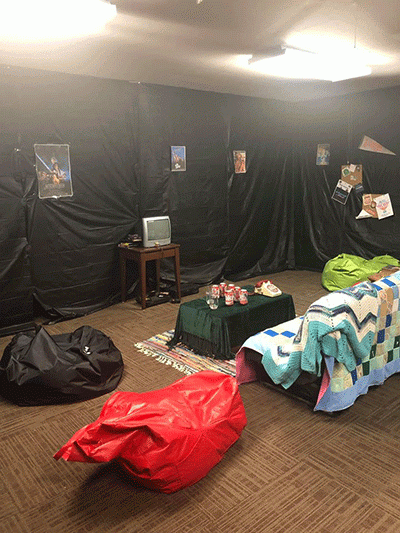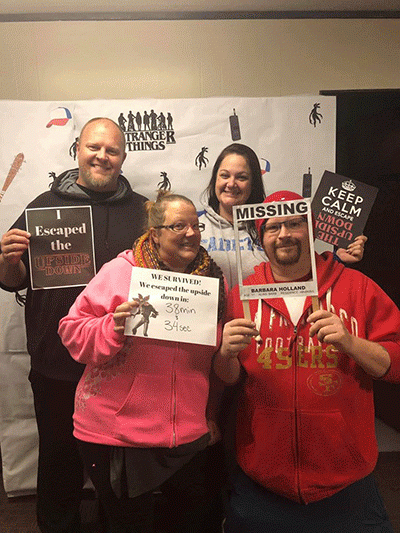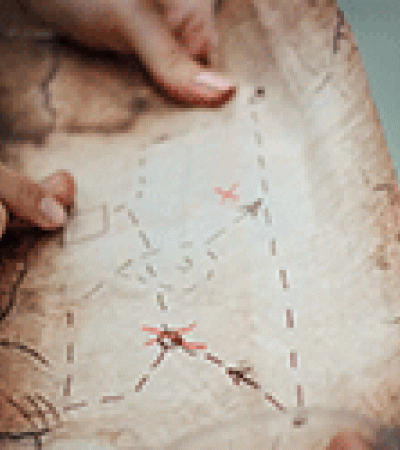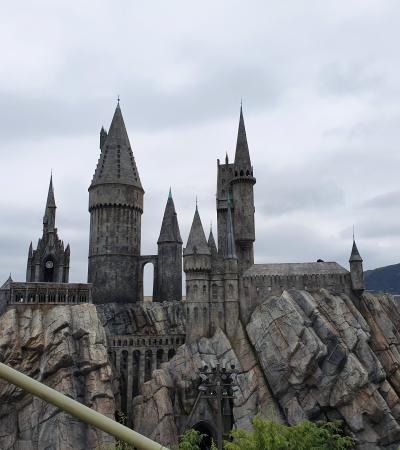An escape room was one of those things that I figured was out the question for a library as small as ours. For one thing, we don’t have any separate rooms to lock people into; our entire library is just one large room. Where would attendees escape from? Plus, escape rooms are complex, high-tech and expensive; it would be impossible to pull it off in a tiny library, right? Wrong!

After attending a Programming Librarian webinar on library escape rooms, I decided to give it a try. I had just hired an enthusiastic library assistant, and we were both big fans of the Netflix show "Stranger Things." The third season had recently wrapped up, and we figured it was the perfect time to do a program based on the show. Here are a few things we learned from our experience.
Use a variety of puzzles and clues
It was so much fun to come up with different puzzles and clues for the escape room. We used things like hidden ciphers, using a UV flashlight to find an invisible message, and we even buried a clue inside a tub full of slime!
It can be helpful to think about the five senses when you’re brainstorming clues. We looked for a mix of the following:
- visual clues
- auditory clues, like playing a piece of music or a noise
- olfactory clues, like having participants smell different things to pick up on a scent (this can be tricky!)
- taste clues (this one is also tricky as one person may experience a flavor differently than another)
- tactile clues (like the slime)
You can hide clues around the room or put clues in puzzles like word scrambles or searches. The possibilities are pretty much endless, but make sure not every puzzle is the same. Try and mix it up as much as you can.
Draw out your map and have a plan
This is a key step in planning an escape room. You may find out that a certain clue won’t work and need to change it, and you don’t want to figure that out after your attendees are already in the room. Having a step-by-step practice walkthrough of the room will be extremely helpful.
Planning an escape room is a lot of work, and it’s easy to get confused when trying to figure out which clue leads where. I would also recommend that you have a staff member or friend play through the room and time it to see how long it takes them to escape. My husband was our guinea pig, and the room ended up taking him about 45 minutes.
Details are important
Details can make or break an escape room. Since "Stranger Things" is set in the 1980s, we had a blast finding different props to scatter throughout our room. We decided to make the back of the library look like an '80s basement hangout, with a ping-pong table, TV, Atari and movie posters everywhere.
We actually didn’t have to buy any props at all. I had tons of props at my own house — a ceramic ET figurine, '80s board games, books, the video game system — and what I didn’t have, I borrowed. We printed a bunch of posters and advertisements from businesses featured in the show, and we even made labels for New Coke to tape over regular Coca-Cola cans.

Another fun detail was our photo booth. We taped up some paper and decorated it with printed out monsters and references to the show, and we made props using paper and popsicle sticks. We took photos of our groups after they escaped and put them on our social media. My library assistant also baked some "Stranger Things"-themed cupcakes, which our attendees loved!
One of my favorite things about the escape room was that the clues led participants outside into our shed. We had emptied out the shed previously, so all that was inside for players to find was a (very creepy) Jack-in-the-Box that had a clue inside.
What they didn’t know was that there was also something else waiting for them outside: my husband in a borrowed Demogorgon mask! He tapped on the windows while they were in the shed and chased them back into the library. We did warn attendees — all teens and adults — that there would be a jump scare, and they were all fine with it and ended up LOVING it.
Players seemed to enjoy that element of surprise, and it was fun to hear them laugh and scream. The best part was, it made for some hilarious footage on our outdoor camera.
It doesn’t have to cost a lot to be fun
We did purchase the Breakout EDU kit several months before our program. The kit costs $150 and is full of different locks, a UV pen, and other helpful ways to create an escape room.
You would not have to purchase this if you didn’t want to; you can find many different kinds of locks on Amazon. You can also check with your local school district or other community libraries to see if they have a kit that you could borrow for a week or two. We decided to purchase it because we are planning on doing more escape rooms in the future.
Other than the Breakout EDU kit, we purchased quite a few black plastic tablecloths from Dollar Tree. We hung these up throughout the room to make it dark and add to the effect of being in the Upside Down.
That was all we had to spend money on. Everything else was either borrowed or belonged to us. The set-up was simple, but the program was at night, and the room looked great in the dark, with only flashlights and Christmas lights to guide the way.

Be a super-fan
I don’t think we could have pulled this off so successfully if we had not been such big fans of "Stranger Things." It’s so important to be enthusiastic and knowledgeable about whatever theme you choose to follow.
If you really want to do a "Harry Potter"-themed escape room but have never seen the movies or read the books, I would suggest you either enlist the help of someone who is obsessed with "Harry Potter" or choose something else that you’re truly passionate about.
Our patrons can tell when we actually care about a program, and it really comes through in the details. When you have enthusiasm and excitement about something, your attendees will pick up on that and get excited too.
Scale up or down, to suit your library
We ended up having three groups of six attend our escape room, and that was perfect for us! We needed hour-long slots for each group (45 minutes for the room and 15 minutes to reset the room), so we would’ve had to extend it another night if anyone else had signed up.
Those 18 people had a GREAT time and thanked us many times for the program. All three groups escaped with just a few minutes left to spare.
Since our library is just one large room, we had to do the escape room in the back section of the library. Luckily, we have a wooden screen that folds across to separate the back section from the front, so the illusion of being in an '80s basement still worked.
We used walkie-talkies to communicate with players if we needed to, and they could ask us for three clues throughout the game. Technically, we could’ve just shouted to them from across the library and they would have heard just fine, but the walkie-talkies added a fun, nostalgic touch. We also set up two baby monitors in the room, so we were able to hear and see the attendees as they moved through the room. This was very helpful for us, as we had to time the Demogorgon “attack” just right. It was also fun to watch them try to work through our puzzles.
Overall, we considered the escape room a great success and can’t wait to do it again. It was a LOT of work and took a lot of set-up time. However, it was all worth it to hear attendees’ excited voices as they stumbled across a clue and see their triumphant happy faces when they managed to escape! So if you’re in doubt, just know that if our tiny library can do it, yours can too.
If you’d like a step-by-step of the puzzles and clues we used for our room, feel free to email me.


